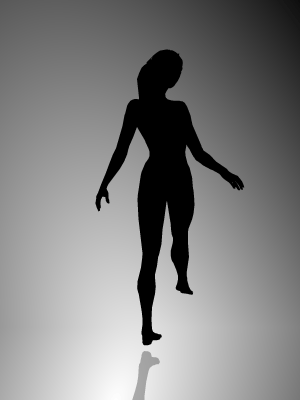Spinning dancer
(Redirected from Spinning Dancer)
Optical illusion of a spinning silhouette
The spinning dancer is a popular optical illusion that involves the perception of a two-dimensional silhouette of a dancer spinning. The illusion is notable for its ability to be perceived as spinning in either a clockwise or counterclockwise direction, depending on the viewer's interpretation. This phenomenon is often used to illustrate the concept of cognitive bias and perceptual ambiguity.
Description[edit | edit source]
The spinning dancer illusion consists of a simple animated GIF that depicts a silhouette of a dancer spinning on one foot. The animation is designed in such a way that the direction of the spin is ambiguous, allowing viewers to perceive the dancer as spinning either clockwise or counterclockwise. This ambiguity arises because the silhouette lacks depth cues, making it difficult for the brain to determine the dancer's orientation in three-dimensional space.
Perceptual Ambiguity[edit | edit source]
The spinning dancer is an example of a bistable perception, where the brain can interpret the same visual information in two distinct ways. This type of illusion highlights the brain's role in constructing reality based on limited sensory input. The direction in which the dancer appears to spin can be influenced by various factors, including the viewer's focus, mental state, and even the lighting conditions in the room.
Cognitive Bias[edit | edit source]
The spinning dancer illusion is often used to demonstrate cognitive bias, particularly in the context of left-brain versus right-brain dominance theories. Some interpretations suggest that individuals who perceive the dancer as spinning clockwise are more "right-brained," associated with creativity and intuition, while those who see it spinning counterclockwise are more "left-brained," associated with logic and analytical thinking. However, these interpretations are largely speculative and not supported by scientific evidence.
Neuroscientific Explanation[edit | edit source]
The perception of the spinning dancer can be explained by the brain's processing of visual information. The visual cortex is responsible for interpreting the ambiguous silhouette, and the lack of depth cues forces the brain to make a "best guess" about the dancer's orientation. This process involves the dorsal stream and ventral stream pathways, which are responsible for spatial awareness and object recognition, respectively.
Related Illusions[edit | edit source]
The spinning dancer is similar to other optical illusions that involve bistable perception, such as the Necker cube and the Rubin vase. These illusions also rely on the brain's interpretation of ambiguous visual information, leading to multiple possible perceptions.
Related pages[edit | edit source]
Search WikiMD
Ad.Tired of being Overweight? Try W8MD's physician weight loss program.
Semaglutide (Ozempic / Wegovy and Tirzepatide (Mounjaro / Zepbound) available.
Advertise on WikiMD
|
WikiMD's Wellness Encyclopedia |
| Let Food Be Thy Medicine Medicine Thy Food - Hippocrates |
Translate this page: - East Asian
中文,
日本,
한국어,
South Asian
हिन्दी,
தமிழ்,
తెలుగు,
Urdu,
ಕನ್ನಡ,
Southeast Asian
Indonesian,
Vietnamese,
Thai,
မြန်မာဘာသာ,
বাংলা
European
español,
Deutsch,
français,
Greek,
português do Brasil,
polski,
română,
русский,
Nederlands,
norsk,
svenska,
suomi,
Italian
Middle Eastern & African
عربى,
Turkish,
Persian,
Hebrew,
Afrikaans,
isiZulu,
Kiswahili,
Other
Bulgarian,
Hungarian,
Czech,
Swedish,
മലയാളം,
मराठी,
ਪੰਜਾਬੀ,
ગુજરાતી,
Portuguese,
Ukrainian
Medical Disclaimer: WikiMD is not a substitute for professional medical advice. The information on WikiMD is provided as an information resource only, may be incorrect, outdated or misleading, and is not to be used or relied on for any diagnostic or treatment purposes. Please consult your health care provider before making any healthcare decisions or for guidance about a specific medical condition. WikiMD expressly disclaims responsibility, and shall have no liability, for any damages, loss, injury, or liability whatsoever suffered as a result of your reliance on the information contained in this site. By visiting this site you agree to the foregoing terms and conditions, which may from time to time be changed or supplemented by WikiMD. If you do not agree to the foregoing terms and conditions, you should not enter or use this site. See full disclaimer.
Credits:Most images are courtesy of Wikimedia commons, and templates, categories Wikipedia, licensed under CC BY SA or similar.
Contributors: Prab R. Tumpati, MD


